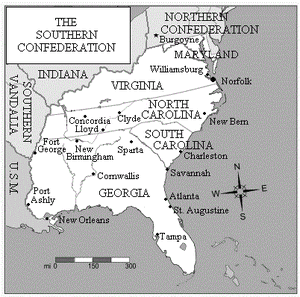
The Southern Confederation was one of the original five confederations that made up the Confederation of North America under the Britannic Design of 1781. Its capital is Norfolk, Virginia, and its largest city is Charleston, South Carolina. The Southern Confederation includes the provinces of Maryland, Virginia, North Carolina, South Carolina, and Georgia. The chief executive is the Governor of the Southern Confederation, and the legislature is the Southern Confederation Council. The S.C. was the last confederation in the C.N.A. to abolish slavery.
The Britannic Design and the Trans-Oceanic War[]
The first Governor-General of the S.C., John Connolly, was sworn in in Norfolk on 2 July 1782, the day the Design went into effect. Connolly encouraged the former supporters of the North American Rebellion to leave the S.C. for the newly-founded settlement of Jefferson in Spanish Tejas. This not only reduced the ill feeling between former rebels and Loyalists, it also allowed those who remained behind to acquire the lands abandoned by the emigrants. In the year following implementation of the Design, some 6,000 white colonists and 1,000 Negro slaves left the ports of Norfolk, Charleston, and Savannah. By the end of the 1780s an additional 17,000 whites and 3,000 Negroes had left the S.C. for Jefferson.
Despite the departure of thousands of former rebels, the S.C. suffered from an ongoing insurrection led by Francis Marion, a former Lieutenant-Colonel in the Continental Army. Operating from bases in the Virginia hill country, Marion and his followers conducted a guerrilla war against the authority of the Southern Confederation until 1796.
Connolly found being Governor-General frustrating; the office had little power, and meetings of the Southern Confederation Council in Norfolk were dominated by Theodorick Bland, the Royal Governor of Virginia. The other four governors either followed Bland's lead, or went their own ways. There was also little cooperation between the S.C. Council and representatives from the other four confederations of the C.N.A. The members of the S.C. Council regarded the inhabitants of Indiana and Manitoba as barbarians, and Bland in particular despised the people of the Northern Confederation, whom he blamed for starting the Rebellion.
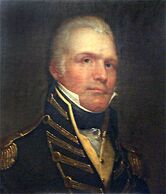
Col. Richard Tomkinson.
When word reached the S.C. in 1795 of the outbreak the Trans-Oceanic War with France and Spain, there was a general celebration in Norfolk. The government of Georgia sent an army under Colonel Richard Tomkinson south to invade Spanish Florida. Tomkinson's men swiftly broke the power of the Seminole Indians and defeated the Spanish garrison, and within a year Georgia had annexed Florida without bothering to gain permission from either the S.C. Council or Parliament.
Following the annexation of Florida, the Georgians joined with North and South Carolina to plan an attack on New Orleans, the major Spanish port at the mouth of the Mississippi River. Governor Bland supported the attack, and he was able to persuade Connolly to arrange for militia units from Virginia and Maryland to join the army marching on New Orleans. General Edward Curtis of Georgia led the S.C. army overland from the Atlantic coast, while a British Army force sailed from New York City in a fleet commanded by Captain Horatio Nelson. The two forces were able to lay siege to the city in September 1797, which surrendered by 1 October. Using the city as a base, Curtis and General Lord Charles Cornwallis were able to strike north up the river, defeating the Spanish and their Indian allies. By the late summer of 1798, all of Spanish Louisiana north of the Arkansas River was in North American hands. Unlike Georgia, however, Louisiana was not annexed by the S.C.; instead, it was formed into a sixth confederation named Vandalia.
The Era of Harmonious Relations[]
The invention of the cotton gin in 1793 eliminated a bottleneck in the production of cotton. The result, during the Era of Harmonious Relations of the early nineteenth century, was a surge in the production of cotton in the S.C., and a vast expansion of the acreage devoted to its growth. However, the increased production also resulted in increased indebtedness, investment in slaves, and an expansion of the African slave trade. Plantations spread across western Virginia and North Carolina, and huge landed estates appeared in the province of Georgia. The rising wealth of the planter class created brilliant social scenes in the Southern cities of Norfolk, Charleston, Cornwallis, and New Orleans.

John Howard
The slave population of the S.C. rose sharply with the rise in cotton production. In 1810, Negro slaves made up a sixth of the confederation's population. By 1836, the proportion had risen to more than a quarter. Slave insurrections became commonplace, with over six hundred individual uprisings recorded during this period. The most significant slave uprising was Howard's Rebellion, which spread from Virginia to the Carolinas in 1815, affecting every major plantation in those provinces and destroying N.A. £20 million worth of property. Although Howard's Rebellion was put down, it inspired other slave uprisings such as the Levering Conspiracy of 1821, and the Insurrection of 1829 which resulted in the deaths of over 1,400 whites and 3,000 Negroes.
By the 1830s, the S.C. had become a vast armed camp, with a large army devoted to maintaining control of the slaves, and the second-largest navy in the world tasked with protecting the slave trade and assisting in the suppression of slave uprisings. The 1830s also saw reduced yields as older cotton fields in the east suffered from eroding soil, and the last of the confederation's unsettled land in western Georgia was brought under cultivation.
Southern politics was divided between the Liberal Party, which was supported by the planter class and their merchant allies in the cities, and the Conservative Party, which was made up of small farmers, urban workers, and the few free Negroes. The Liberals supported low tariffs, improvements to the confederation's ports and waterways, and a large military. The Conservatives sought higher tariffs, subsidies for industrial plants, a limit to the size of plantations, and a smaller military.
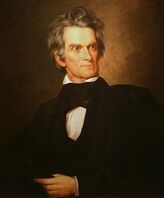
Governor-General John Calhoun.
Initially, neither major party opposed the continued expansion of slavery. However, in the wake of the Levering Conspiracy, abolitionist sentiment rose until a number of abolitionist organizations such as the Anti-Slavery Society of Norfolk joined together in 1825 to form the Southern Union. Liberal leader John Calhoun of Georgia took a strong stand against abolitionism, delivering his Defense of the Realm speech after the Insurrection of 1829. In his speech, Calhoun insisted that slavery, right or wrong, was essential to the confederation's power and prosperity, and must be maintained.
Conservative leader Willie Lloyd of South Carolina took the opposite approach, calling slavery "the bane of our state, bleeding us at every occasion, destroying the fabric of our society, and making slave and slaveholder alike less than men." Lloyd allied the Conservatives with the Southern Union and with British abolitionists. The 1833 elections produced a Liberal majority, and Calhoun became Governor-General of the S.C. Under Calhoun, slavery continued to maintain its grip on the confederation.
Manumission[]
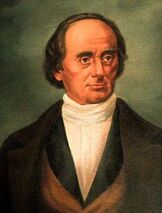
Governor Willie Lloyd of South Carolina.
Southerners had been willing to endure the social and economic burdens imposed by slavery as long as cotton remained a profitable commodity. However, when the Panic of 1836 struck, the price of cotton fell, and with it the price of slaves. A prime field hand who was worth N.A. £150 in the spring of 1835 had fallen in value to N.A. £30 by October 1837. By February 1838, the price of slaves had fallen below the cost of transporting them from Africa, and the slave trade collapsed the following year. By then, the falling price of cotton had forced many plantation owners to abandon its production in favor of vegetables and grains for their own consumption. Southern plantations resembled miniature feudal estates, as commerce collapsed and Southerners were forced to accept lower standards of living.
In August 1838, Lloyd responded to Governor-General Calhoun's defense of slavery by claiming that civilization in the S.C. would not be threatened by manumission, and proposing that all the confederation's slaves be freed over a period of ten years, with the government compensating the owners. The following year, British Prime Minister Sir Duncan Amory called for the abolition of slavery throughout the British Empire, promising financial and administrative aid in manumission programs.
Citing Amory's pledge, Lloyd in the spring of 1840 proposed the payment of N.A. £35 per slave to any and all slaveholders who would accept the price, with the money to be raised through the sale of "manumission bonds" in Britain and the C.N.A. The offer would end on 1 January 1842, at which time all remaining slaves would be freed at a rate of N.A. £32. Since the price of slaves in the S.C. had declined to N.A. £19 two years before, manumission would be a way for cash-starved plantation owners to recoup their fortunes.
The Lloyd bill also arranged for the education and training of the former slaves, while a provision inserted into the bill by James Philipson required that former slaves be bound to their plantations until their period of education was over. The Philipson Provision would later be used to keep the former slaves and their descendants bound to the soil for another two generations.
After bitter wrangling in the S.C. Council in Norfolk, the Lloyd Bill was passed, and sent to Viceroy Sir Alexander Haven in Burgoyne for ratification, which he gave on 16 May. There was talk in the S.C. of revolution in the week before ratification, but in the event there were few disturbances. Although Sobel does not say so, it is likely that the muted response was due to many slavery supporters choosing to move to Jefferson with their slaves rather than see them freed. It is possible that Calhoun himself did so, since a former slave named Miguel Calhoun was a leader of the Rainbow War in 20th century Mexico.
Within six months of the Lloyd Bill's passage, half of the slave owners in the S.C. had accepted the manumission program, and before the deadline almost every slave in the S.C. had been freed. However, few of the freed slaves were permitted to leave the plantations. John Harnett wrote in 1935 that "Southern Confederation slaves exchanged one form of slavery for another" while the planters "now found themselves with more money than they had had since 1835, less responsibility, and for the first time in a century, without the fear of slave revolts. One might easily say that the Lloyd bill did not grant freedom to the slaves, but rather to their masters."
Second Design and Rocky Mountain War[]
The collapse of the Southern economy in the late 1830s was echoed by chaos and disruption elsewhere in the C.N.A. The Northern Confederation suffered its own economic collapse, compounded by a general strike and the violent suppression of the Grand Consolidated Union by Governor Henry Gilpin. Indiana experienced an Indian uprising led by Chief John Miller and the fall of Michigan City to Miller's army. Quebec suffered from a separatist uprising in September 1839 led by Louis Papineau.
As far back as the Defense of the Realm speech in 1829, Calhoun had called on his fellow Liberals in the other confederations to join together in defense of the status quo. In the summer of 1841, as his fellow slaveowners were freeing their slaves in advance of the Lloyd Bill's deadline, Calhoun put his proposal into effect, calling for a general convention of Liberal delegates to meet in Concordia, North Carolina. When the delegates met in July, Calhoun joined together with Gilpin and General Winfield Scott of Indiana to work out a joint strategy. The delegates agreed that the people of each confederation must take an interest in affairs in the others, and that a threat to one represented a threat to all. They also agreed that Chief Miller's uprising could be repeated elsewhere in the C.N.A., and that a strong standing army was a necessity. The economic crisis revealed the need for a common currency and a national banking system. The Concordia Convention ended in August by issuing a call for the Britannic Design to be amended to create a closer union and a more centralized nation. The C.N.A.'s conservatives responded to the Concordia Convention by holding their own in Brant, Indiana in September. Like the Liberals, they called for a more united nation.
Haven agreed to submit the resolutions of the two conventions to the Crown for action by the British government. Both Amory and Queen Victoria responded favorably, and Parliament approved a special session of the Grand Council to consider amendments to the Design. The special session began in June, and over the course of three months the Councilmen, led by Scott and Lloyd, drafted a set of far-reaching amendments to create what became known as the Second Britannic Design. The Grand Council itself was to be remade into a legislature of 150 members elected to five year terms. The Governor-General became the head of government, chosen by a majority of the Grand Council.
Elections for the new Grand Council took place in February 1843. Lloyd was generally recognized as the head of the new National Conservative Party, and was expected to become governor-general in the event the N.C.P. gained a majority. During the campaign, Lloyd called for a broad program of social reform, while Unified Liberal leader Scott favored expansion of the railroads and settlement of the frontier confederations of Manitoba and Vandalia. The return of prosperity and growing tensions with the United States of Mexico favored the U.L.P., which won eighteen of the S.C.'s thirty seats in the Grand Council, contributing to a national majority of ninety-one seats. Lloyd was one of twelve National Conservatives who won their seats in the S.C., and he became the Minority Leader in the newly-elected Council, leading the opposition to Scott's government.

Gen. FitzJohn Smithers
With Gilpin serving as Scott's Minister of War, the C.N.A. drifted closer to war with Mexico, which finally broke out in September 1845. The Rocky Mountain War proved to be as disruptive as the Panic of 1836 had been. Former slaves in the S.C. refused to serve in the military unless their demands for equality were met, and Scott's government was in no position to refuse. Released from the restrictions of the Philipson Provision, the freedmen formed a growing proportion of the S.C. army, which launched an attack on Jefferson across the Mississippi River in April 1846. Although initially successful, the S.C. troops were forced to withdraw after two weeks of bitter fighting. A second Southern army under General FitzJohn Smithers was sent across the Rocky Mountains in the summer of 1850 in an attempt to rescue an earlier army from being trapped in Williams Pass by two Mexican armies. The attempt failed, and a majority of Smithers' army was lost in the terrible Battle of Williams Pass.
Growing friction between Scott and his Minister of War led finally to an open rupture in April 1849, as Gilpin resigned from the Cabinet and accused Scott of incompetence and refusal to support the troops. Gilpin's allies in the Grand Council joined with the National Conservatives to pass a motion of no confidence. Scott spent three weeks attempting to form a coalition government with the N.C.P., but Lloyd refused, determined to force a snap election. Gilpin was able to outmaneuver Lloyd, however, gaining control of the U.L.P. caucus in the Grand Council, and forming his own coalition government with a group of pro-war National Conservatives. Lloyd's efforts were finally defeated on 15 May, when Gilpin was able to win a confidence vote with 78 votes.
Lloyd's maneuvering cost him the support of the anti-war faction of the National Conservatives. As the war continued to go badly under Gilpin's government, public opposition to the war grew. As the 1853 Grand Council elections approached, Lloyd was replaced by the party caucus, who chose Councilman William Johnson as the N.C.P.'s new standard-bearer. Johnson called for an immediate halt to the fighting, and a unilateral withdrawal of North American forces from the Mexican state of Arizona, followed by a peace conference with the Mexicans to determine the fate of the occupied portion of Mexico del Norte. Under Johnson's leadership, the N.C.P. won fifteen seats in the S.C., and a total of 91 seats in the Grand Council.
Corruption and Reform[]
Johnson acted quickly to bring the war to a close. In April 1853, he and Mexican President Hector Niles agreed to begin negotiations for a peace treaty in The Hague, and declared an armistice that would take effect on 1 August. By the time both nations signed the Hague Treaty in 1855, peace and prosperity had returned to the C.N.A.
The abolition of slavery in the S.C. brought it closer culturally and socially to the Northern Confederation and Indiana. Industrialization took hold in the Tennessee River area of North Carolina and Georgia, with steel production, fabricating plants, mills, and rail terminals in place by 1870 and the growth of the new industrial centers of New Birmingham, Clyde, and Lloyd. New Orleans and Charleston became huge cities, dwarfing their European counterparts, and rivaling New York City and Michigan City in size.
Despite the gains made by many former slaves during the Rocky Mountain War, the Philipson Provision continued to keep most of the S.C.'s Negroes in a state of quasi-serfdom immediately after the war. According to the 1860 census, 1.7 million of the S.C.'s 2.5 million Negroes were still bound to the soil, over half of the 3.3 million Negroes in the C.N.A. But the days of the Philipson Provision were coming to a close. By 1880, only 1.1 million of the country's 5.9 million Negroes remained in the Southern Confederation; twice as many were now living across the Mississippi in Southern Vandalia, and another one million had emigrated to the cities of the Northern Confederation.
The farmers and small businessmen of the S.C. formed the country's largest pool of Conservative voters. In the 1858 Grand Council elections, the Conservatives won 17 of the confederation's 30 seats, though this proved insufficient to prevent the Liberals from regaining control of the legislature. By 1868, though, Conservative strength had grown to the point where they were able to win 21 seats, enough to tip the balance for Conservative party leader Herbert Clemens to win a majority in the Grand Council.
In 1869, the growing corruption of both major parties by the wealth of the industrial corporations left the small farmers and impoverished plantation owners of the S.C. convinced that there was no place for them in either. Thus, they came together in Norfolk to found a new People's Party. The delegates in Norfolk drafted the Norfolk Resolves, calling for higher taxes on corporations, the establishment of government banks to offer low interest loans to farmers, and a state agency to control the rates set by railroads, turnpikes, and canals. Word of the new party soon spread throughout the C.N.A., and branches were founded in all the other confederations. Now known as the People's Coalition, the new party put up candidates in local and confederation elections, and in 1873 ran a full slate of candidates for the Grand Council, winning ten seats.
The P.C. benefitted from election reforms instituted by the Conservatives, widening the franchise and redrawing electoral districts. The redistricting was meant to concentrate Liberal voters in as few districts as possible, but the appearance of the Coalition upset the Conservatives' calculations. In the 1873 elections, instead of increasing the Conservative seats in the S.C., Governor-General Clemens' reforms reduced their number from 21 to 17. The Liberals also saw their seats fall from 9 to 7, while the Coalition won the remaining 5. Control of the provincial legislatures in Virginia and North Carolina also passed from the Conservatives to the Coalition.
Due to a combination of Clemens' electoral reforms and the expiration of the Philipson Provision, Negroes were becoming an important voting bloc in the S.C. However, by the 1870s, they no longer saw the Conservatives as the Party of Lloyd, but as that of the English and Irish immigrants who were competing with them for industrial jobs. The Liberals, on the other hand, still bore the taint of John Calhoun. As a result, the new Negro voters increasingly joined the equally new People's Coalition.
The stunning victories won by the Coalition in 1873 left the older parties fearful, and as the 1878 Grand Council elections got under way, they responded with a wave of political violence directed at the new party. In the Southern Confederation, several of the Coalition's Grand Council candidates were waylaid and badly beaten (probably the Negro ones, though Sobel doesn't specify their race). Despite the violence, the Coalition was able to win four Southern Confederation seats from the Conservatives, increasing their delegation in the S.C. to nine seats, and in the C.N.A. as a whole to 39.
Both of the older parties lost ground to the Coalition in the Grand Council, but the Conservatives particularly so, leaving the Liberals with a 62 seat plurality. Rather than form a coalition government with one of the other parties, Liberal Party leader John McDowell chose to form a minority government, relying on pro-reform candidates from the other two parties to give him a working majority. McDowell proved sufficiently skilled politically to gain passage of several important reforms, and to avoid antagonizing his political opponents to the point where they would join together in a no-confidence vote.
In the Southern Confederation's provincial legislatures, the Conservatives managed to maintain a narrow plurality over the Coalition, and even gained ground in the 1879 provincial elections. However, its strength elsewhere in the C.N.A. was ebbing. The Coalition, by contrast, received a boost in 1880 when a financial panic brought on a deep recession known as the Great Depression, radicalizing many North American voters. In the 1883 Grand Council elections, the Coalition's candidates won eleven seats in the S.C., to the Liberals' ten and the Conservatives' eight. Nationally, the Liberals and the Coalition both made gains at the expense of the Conservatives, with the former gaining a majority of 82 seats, and the latter surging past the Conservatives to become the official opposition.
Now that the Liberals had absolute control of the Grand Council, they could fully implement what McDowell called his Age of Renewal programs. Unfortunately, McDowell's programs proved too ambitious and expensive. Taxation reached unprecedented levels, and the end of the Great Depression brought increased inflation. By the 1888 Grand Council elections, public dissatisfaction with the Liberals allowed the Coalition, under Michigan City Mayor Ezra Gallivan, to win their own plurality of seats. In the Southern Confederation, the Conservative Party suffered an almost complete collapse, losing all but one seat to the Coalition, which won 19 of the confederation's 29 seats.
The Starkist Terror[]
The coming of the Great Depression in the early 1880s coincided with the failure of republican government in the United States of Mexico, and the rise to power of Benito Hermión. As Gallivan organized for the 1888 elections, Hermión sent his armies into the nation of Guatemala and installed a puppet ruler. With Guatemala under his control, Hermión looked beyond it to New Granada, denouncing its government and claiming it was preparing to attack Mexico. While Gallivan implemented his reform program in the C.N.A., Hermión prepared his attack on New Grenada, finally launching it in March 1890. Gallivan "deplored the seizure of this land which had done no harm," and offered asylum to New Granadan refugees, but refused to allow them to form a government-in-exile in Tampa, and did nothing to disturb trade relations between the C.N.A. and Mexico. Gallivan did increase military appropriations in 1892, but he would make no aggressive moves against Hermión. He said, "So long as El Jefe seeks his destiny to the south, we shall do nothing. But if the tyrant looks to the north or to the east, he shall be dealt with severely."
Kramer Associates, the Mexican corporation that had backed Hermión's seizure of power in 1881, was seeking copper to mine in Russian Alaska. A treaty with the Russian government in 1894 granted K.A. a mineral concession in Alaska. When gold was discovered by a K.A. prospecting crew, the Russians reneged on the deal, and K.A. President Diego Cortez y Catalán began plotting war. In 1898, Cortez maneuvered the Russians into war with Mexico, and Alaska was quickly overrun by Mexican troops.
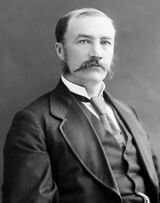
Councilman Fritz Stark.
The Mexican conquest of Alaska sent shock waves running through the C.N.A. The legislatures of Manitoba and Northern Vandalia passed resolutions seeking increased military spending. On the campus of Georgia University, the head of the 100,000-member Students Defense League, Frank Mitchell, called for Gallivan's removal "by whatever means necessary." The agitation against Gallivan's isolationist foreign policy increased in the summer of 1899, when Mexican ships launched an amphibious invasion of Siberia. On 10 July 1899, Councilman Fritz Stark of Georgia gave a speech in the Grand Council in which he accused Gallivan of being "in the pay of the Kramer Associates, which has purchased our foreign policy, lock, stock, and barrel."
The result of the Stark speech was a wave of violence across the C.N.A., directed at Gallivan's allies. In two weeks, 436 people were killed including Councilman Dudley Graves of Indiana. At Gallivan's insistence, a committee was empowered by the Grand Council to investigate Stark's accusations. The committee found that Stark had been taken in by forgeries, and that there was no trace of the money Gallivan had supposedly received from K.A. Stark recanted his accusation and resigned his seat on 6 August, and committed suicide the next day, but the agitation against Gallivan continued unabaited. Gallivan was finally forced to resign on 24 July 1901.
Cortez had been satisfied with the conquest of Alaska, and had opposed Hermión's invasion of Siberia. When Hermión declared himself Emperor of Mexico on 1 April 1901, Cortez began preparing for his overthrow, which he accomplished in October. With Hermión gone, the Starkist Terror vanished from the C.N.A., and a pro-Gallivan reaction set in. Gallivan chose not to return to public life, but his influence enabled his protégé Christopher Hemingway to become leader of the People's Coalition in 1903. Hemingway led the Coalition to a landslide victory in the 1903 Grand Council elections. In the S.C., Coalition candidates won 22 of the confederation's 28 seats. Five years later, Hemingway's successor Albert Merriman won an even greater victory, gaining 24 seats in the S.C., and 90 across the nation.
The Diffusion Era and After[]
Gallivan's resignation marked the start of a political era called the Years of the Pygmies marked by economic prosperity and quiescent politics. That era ended in 1915, when Southern Vandalian Governor Howard Washburne denounced the decision by Mexican President Victoriano Consalus to put thousands of Negro slaves on trial for treason for joining an invading French army during the Hundred Day War. Washburne formed the Friends of Black Mexico to agitate for the end of slavery in Mexico. The F.B.M. was implicated in the Chapultepec Incident, when thousands of young people, many of them North Americans, stormed the Federal Prison in Chapultepec and freed the imprisoned slaves. Consalus and Merriman were able to avert war between the two countries, but the issue of Mexican slavery revealed a deep divide between whites and Negroes in the C.N.A. When F.B.M. members held silent vigils in January 1916 outside Mexican consulates in the S.C. and elsewhere across the country, they were attacked by anti-Negro gangs.
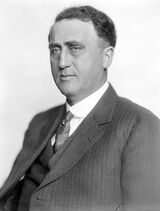
Governor Chester Phipps.
The racial enmity revealed by the reaction to the Chapultepec Incident exposed a more pervasive division within the C.N.A, a reaction among many North Americans against the growing urbanization and industrialization of the country. This reaction reached its peak in the summer of 1922, spurred by the growth of the League for Brotherhood, a successor to the F.B.M. A faction within the Liberal Party sought to gain the support of the new radicals, proposing to nominate Washburne for governor-general. They were successfully opposed by Liberal Party leader Chester Phipps of the Southern Confederation. Phipps said, "Mr. Washburne is a saint. But saints are notoriously poor politicians." At the Liberals' nominating convention in December 1922, Phipps and his supporters were able to deny the nomination to Washburne, nominating instead Councilman Henderson Dewey of Indiana. The P.C., in their own convention that month, renominated Governor-General Calvin Wagner. Thus, both major parties rejected the new radicalism, leaving it with no political means to accomplish its objectives.
The political situation changed literally overnight after locomobile magnate Owen Galloway proposed to end the crisis by subsidizing emigration in and from the C.N.A. Both the new radicals and their opponents embraced the Galloway Plan, and over the course of the 1920s almost 2 million people left the C.N.A., or emigrated to the confederation of Manitoba. The population of the Southern Confederation remained static for three years as natural increase was balanced by emigration; only after 1926 did the confederation's population begin to rise again.
Dewey was able to take advantage of Galloway's popularity to win a majority in the 1923 Grand Council elections. Even in the Southern Confederation, the Liberals were able to win 14 seats to 13 for the Coalition. Since Coalitionists who opted to emigrate tended to leave the C.N.A. rather than move within it, their numbers fell steadily through the 1920s. In the 1928 elections, the Liberals gained an additional three Southern seats from the Coalition. Dewey's successor, Douglas Watson, gained three more seats in the 1933 elections, giving the Liberals 20 Southern seats to the Coalition's 7.
Although Watson continued to follow Dewey's domestic policies, he sought a more active foreign policy, and this proved his undoing when Galloway came out against his proposed increases in military spending. Combined with the recession following the Panic of 1936, the military spending issue cost the Liberals their enormous Grand Council majority in the 1938 elections, which resulted in a narrow victory for the Coalition under Councilman Bruce Hogg.
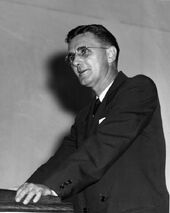
Governor-General Richard Mason.
When a general war broke out in Europe in October 1939, Hogg maintained North American neutrality, confining himself to covert arms shipments to the British via Iceland. The C.N.A. avoided the death and destruction that the rest of the world suffered, but fell victim to a national mood of survivor's guilt. Southern Confederation Councilman Richard Mason took advantage of the country's mood to win passage of a massive foriegn aid program called the Mason Doctrine in 1950. Three years later, Mason was able to lead the Liberals to victory in the 1953 Grand Council elections.
As the Southern Confederation's population continued to fall relative to the rest of the country, it continued to lose seats following each decennial census. The S.C. held 20 seats in the 1950s, then 18 seats in the 1960s. Mason maintained an 11 to 9 seat advantage over the Coalition in his two successful elections in the 1950s, but 1963 saw the S.C.'s seats split evenly between the two parties, with an 80 seat Coalition majority in the nation as a whole. When the Liberal Party split in the 1968 elections, the Coalition won 10 Southern seats to seven for the Liberals and one for the new Peace and Justice Party.
Sources[]
Sobel's sources for the Southern Confederation are Sir Malcolm Smith's An Address to the People of the Southern Confederation (Norfolk, 1834); Sir Joshua Hendly's Travels Through the Southern Confederation in the Winter of 1833 (London, 1835); Calhoun's Defense of the Realm and Other Essays (Norfolk, 1845); Frank Stroud's "Calhoun in Defeat: The Lost Cause of '39" from Annals of the Southern Confederation Vol. XXXVI, No. 5 (April, 1889); Roscoe Symes' The End of the Slave Trade (Norfolk, 1904); Beauregard Hopkins' The Pearl of the Southern Confederation: Life in Early Georgia (Atlanta, 1906); Arthur Ruppert's Georgian Feudalism (New York, 1910); John Harnett's A History of Slavery in the Southern Confederation (London, 1935); Sir Humphrey Grey's Particularism and Colonial Rights in the Southern Confederation (London, 1940); Theodore Holmes' Slave Rebellions of the 1820s (New York, 1945); Marshall Butler's The Paradox of the Black Vote (Burgoyne, 1955); Percy Harcourt's The Vipers in Their Bosoms: Clinton and Bland in 1788 (London, 1956); John Pritchard's William Lloyd: The Southern Emancipator (New York, 1956); Martin Tucker's The Rise of the New Southern Confederation (New York, 1960); George Caldwell's Free Men in a Slave State: The Origins of the Southern Union (New York, 1964); Ernest Passman's Lloyd of Carolina: A Political Biography (New York, 1965); John Snodgrass's Cotton as a Factor in the Southern Confederation (New York, 1965); Bernard Telford's Georgia and the Rise of the Southern Confederation (Mexico City, 1965); H.C. Hartwick's Black Skin and Red Ink: Profits in the Slave Trade, 1820-1840 (New York, 1967); and Ricardo Rodriguez's Slavery as an Issue in the Southern Confederation (Mexico City, 1970).
This was the Featured Article for the month of July 2015.
| Governors of the Southern Confederation |
|---|
| John Connolly • John Calhoun • Willie Lloyd • Chester Phipps |
| Confederations of the C.N.A. |
|---|
| Central Confederation • Indiana • Manitoba • Northern Confederation • Northern Vandalia • Quebec • Southern Confederation • Southern Vandalia • Vandalia |
